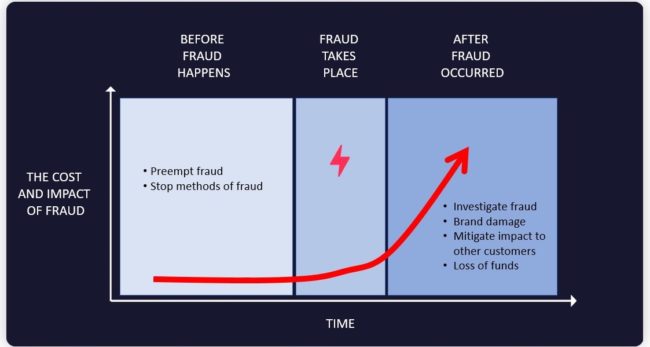Appdome Mobile Fraud Prevention is here! The team asked me to share my thoughts on the what, and why, we developed the industry’s first preemptive anti-fraud solution for mobile apps.
Throughout my career, I’ve been battling digital fraud with some of the world’s largest organizations and law enforcement agencies. Before becoming a part of Appdome, I founded BlockchainIntel to combat fraud in the blockchain industry. One of the biggest challenges I found in combatting mobile fraud was the reactive nature of stopping fraud.
In reality, most solutions depend on the fraud actually occurring before organizations can do anything about it. For years, I worked with Financial Fraud teams, who employed data scientists or used data analysis products to identify fraud. But identifying fraud after it happens also means dealing with the damage the fraud causes after it has been committed. After fraud happens, the user and company have lost funds, lost trust, and suffered reputation loss.
Appdome’s no-code mobile fraud prevention solution turns the fraud market upside down. Instead of waiting for mobile app fraud to occur, Appdome’s solution preempts fraud in and from Android and iOS apps – stopping fraud before its starts.
Mobile Fraud is a Multi-Billion Dollar Problem
In the last year, it’s been estimated that the mobile industry lost nearly $24B to mobile click fraud. That’s $24B lost to fake clicks and events generated by malware, scripts and other programs that abuse how mobile apps and the Android and iOS operating systems work. And mobile app fraud doesn’t stop there. Fake users, account takeovers (ATOs) and overlay attacks are on the rise. In September 2020, the FBI issued a warning to all financial services organizations that credential stuffing attacks, large-scale automated attacks that “guess” usernames and passwords were increasing substantially. Bottom line, mobile fraud is a big business and a real problem.
Fraud Monitoring and Data Analysis Alone Can’t Solve Mobile Fraud
When you look at the current state of the B2B Fraud Prevention market, the solutions focus on identifying fraud by distinguishing good or legitimate acts from fraud. Distinguishing good acts from fraud requires lots of data from the mobile app channel. As the data comes in, the fraud monitoring and data analysis based anti-fraud systems analyze the data to determine which events are “good,” and which are fraud. Even if these systems are armed with rich analytic engines, Artificial Intelligence, and pattern matching, their Achilles heel is the need to “learn” what is good from bad, legitimate vs. fraud. As these systems learn, fraud and other bad acts will occur and sometimes, before these systems learn what bad behavior is, fraudsters change their strategies. As a creator and user of these systems myself, the system’s learning process can also lead to false positives, i.e., good events misidentified as fraud.
Stopping Mobile Fraud at the Network Level Isn’t Enough
The other challenge I found with existing mobile fraud prevention solutions is that they are designed to protect networks and network resources first. What I mean is that, while the fraud is occurring and fraud prevention systems are learning, mobile end users (i.e. people) are being impacted by the fraud. Also, when a bad act is identified and the system enforces protections against fraud, these enforcement points normally include blocking network traffic. Even though the network is protected, the target mobile end user and app remain at risk.
Stopping Mobile Fraud Before It Starts
The big question in mobile fraud prevention is how to stop fraud before it starts?
This chart shows the evolution of mobile app fraud and provides a model for security and fraud teams to evaluate solutions to prevent mobile app fraud. Best practice would suggest that you use solutions in each of the three stages of mobile fraud prevention to provide a comprehensive protection against mobile fraud.

Delivering on true mobile fraud prevention includes stopping mobile fraud before it starts. On top of AI based systemic learning, network devices, round-trip time, proxies, reverse proxies and the like, developers should deploy mobile apps that defend and protect against mobile fraud.
Mobile apps can be made to defend and protect themselves against mobile fraud. There are many ways fraudsters abuse mobile apps, mobile operating systems and devices to carry out fraud. Some of the most widely known include click bots, mobile malware, cheat engines, using large scale virtualized environments to carry out credential stuffing, mobile app overlays, mobile app clones, fakes or trojans and on and on. Powerful tools that allow dynamic instrumentation as well as masking, cloaking and hiding mobile operating system compromises and accessibility and/or privilege abuse are widely and easily available. What’s particularly harmful about these new challenges is that they take advantage of the way mobile apps work, weaponizing Android and iOS apps and abusing legitimate functionality of operating systems. With Appdome’s new No-Code Mobile Fraud Prevention solution, Appdome blocks all the ways mobile apps are used and abused to carry out fraud – before it starts.
Are you Ready to Stop Mobile Fraud Before It Starts?
By using Appdome Mobile Fraud Prevention to preempt fraud, you can increase the impact you have on your fraud number. Appdome Mobile Fraud Prevention helps risk, security and fraud teams to root out fraud before it comes onboard. As a result, companies can prevent reputation loss, lost funds and reduce the resources needed to address fraud.
Please try our no code Mobile Fraud Prevention Solution and join us in the battle to stop mobile fraud before it starts.
Request a Mobile Fraud Prevention demo today to learn more.






